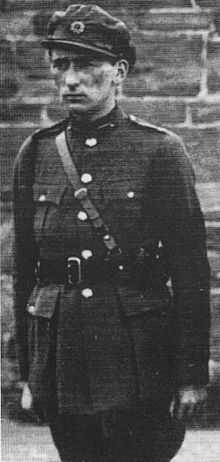The Squad (Irish Republican Army unit)
The Squad or the Twelve Apostles was an Irish Republican Army (IRA) unit founded by Michael Collins to counter British intelligence efforts during the Irish War of Independence, mainly by means of assassination.
Background
On 10 April 1919, the First Dáil announced a policy of ostracism of Royal Irish Constabulary men. At the time Sinn Féin official policy was against acts of violence. Boycotting, persuasion and mild intimidation succeeded against many officers. However others escalated their activities against republicans and in July 1919 Collins asked Dick McKee to select a small group to form an assassination unit.[1]
Assassination

The founder members were Paddy Daly (leader), Patrick Buckley, Mick McDonnell, Ben Barrett, James Conroy, Sean Doyle, Joe Leonard, Pat McCrea, Jim Slattery, and Bill Stapleton. They were employed full-time and received a weekly wage.[2]
On 30 July 1919, the first assassination authorised by Michael Collins was carried out when Detective Sergeant "the Dog" Smith was shot near Drumcondra, Dublin.[2] The Squad would continue targeting plainclothes police, members of the G Division of the Dublin Metropolitan Police, and—occasionally—problematic civil servants. Organisationally it operated as a subsection of Collins' Intelligence Headquarters. Two of the executions by The Squad" were the killing on January 21, 1920 of RIC Inspector William Redmond of the DMP "G" Division[3] and on March 2, 1920 a British double agent John Charles Byrnes [4]
Further members included Mick Love, Gearoid O'Sullivan, Patrick Caldwell, Charlie Dalton, Mick O'Reilly, Vincent Byrne, Sean Healy, James Ronan, Tom Keogh, Tom Cullen, Paddy Lawson, John Dunne and Johnny Wilson. Seán Lemass and Stephen Behan (the father of Irish writers Brendan and Dominic Behan) have also been put forward as members of the Apostles. Understandably, there is no hard evidence to support many of these names; however, those that subsequently served in the Irish Army have their active service recorded in their service records held in the Military Archives Department in Cathal Brugha Barracks, Rathmines. Dr. Andy Cooney is also reported to have been associated with "The Squad".
Bloody Sunday
One of the Apostles' particular targets was the Cairo Gang, a deep cover British intelligence group, so called since it had either been largely assembled from intelligence officers serving in Cairo or from the Dublin restaurant called the Cairo, which was frequented by the gang. The Cairo Gang was brought in during the middle of 1920 by Sir Henry Wilson explicitly to deal with Michael Collins and his organization. Given carte blanche in its operations by Wilson, the strategy adopted by the Cairo Gang was to assassinate members of Sinn Féin unconnected with the military struggle, assuming that this would cause the IRA to respond and bring its leaders into the open.
The most well-known operation executed by the Apostles occurred on Bloody Sunday, November 21, 1920, when British MI5 officers, linked to the Cairo Gang significantly involved in spying, were shot at various locations in Dublin (14 were killed, six were wounded). In addition to the "Twelve Apostles", a larger number of IRA personnel were involved in this operation. The only IRA man captured during the operation was Frank Teeling. In response to the killings, the Black and Tans retaliated by shooting up a Gaelic football match between Dublin and Tipperary at Croke Park, killing fourteen civilians including one of the players, Michael Hogan, and wounding sixty-eight. The Hogan stand (as in Croke Park) is named after him.
Dublin Guard
In May 1921, after the IRA's Dublin Brigade took heavy casualties during the burning of the Custom House, the Squad and the Brigade's "Active Service Unit" were amalgamated into the Dublin Guard, under Paddy Daly. Under the influence of Daly and Michael Collins, most of the Guard took the Free State side and joined the Irish Army in the Irish Civil War of 1922-23. During this conflict some of them were attached to the Criminal Investigation Department and were accused of multiple assassination of Anti-Treaty fighters.
Later years
Bill Stapleton went on to become a director in Bord na Mona, Charles Dalton and Frank Saurin became directors in the Irish Sweep Stakes. Dalton was the subject of a Kevin Myres article, Myres questioned Dalton living in Morehamton Road in 1940, but did not research his article enough to mention that Dalton was a director in the Sweep stakes at the time. In October 1923, Commandant James Conroy was implicated in the murder of two Jewish men, Bernard Goldberg and [[Emmanuel 'Ernest' Kah[a]n]]. He avoided arrest by fleeing to Mexico, returning later to join the Blueshirts. [5] A later application for an army pension was rejected. The killings were the subject of a 2010 investigative documentary by RTÉ; CSÍ: Murder in Little Jerusalem.[6]
References
- ↑ Michael Collins: A Life;James Mackay Chpt 8
- ↑ 2.0 2.1 Mackay, James. Michael Collins: A Life, p.132
- ↑
- ↑
- ↑ Bushe, Andrew (24 June 2007). "Killing spree led to fear of pogrom on Dublin Jews". Irish Independent (Independent.ie). Retrieved 14 October 2010.
- ↑ "CSÍ : Murder in Little Jerusalem" (in Irish (with English subtitles) Note - Limited availability). RTÉ Factual. broadcast 11 October 2010. pp. 25 mins. Retrieved 14 October 2010. Check date values in:
|date=(help)
Bibliography
- The Squad and the Intelligence Operations of Michael Collins T. Ryle Dwyer